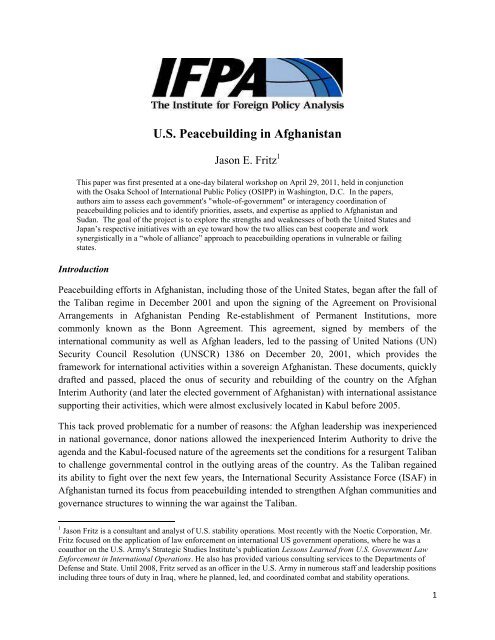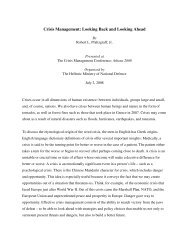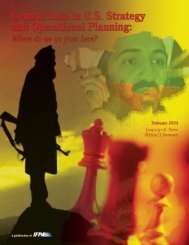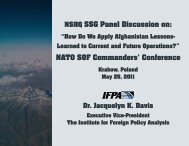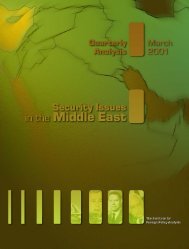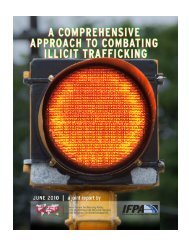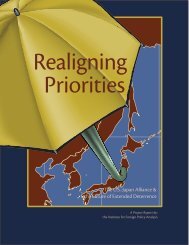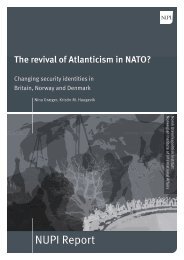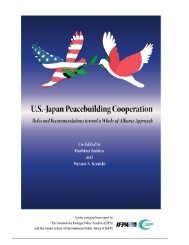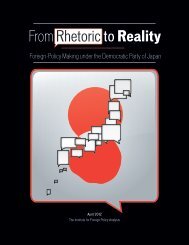US Peacebuilding in Afghanistan - Institute for Foreign Policy Analysis
US Peacebuilding in Afghanistan - Institute for Foreign Policy Analysis
US Peacebuilding in Afghanistan - Institute for Foreign Policy Analysis
Create successful ePaper yourself
Turn your PDF publications into a flip-book with our unique Google optimized e-Paper software.
U.S. <strong>Peacebuild<strong>in</strong>g</strong> <strong>in</strong> <strong>Afghanistan</strong>Jason E. Fritz 1This paper was first presented at a one-day bilateral workshop on April 29, 2011, held <strong>in</strong> conjunctionwith the Osaka School of International Public <strong>Policy</strong> (OSIPP) <strong>in</strong> Wash<strong>in</strong>gton, D.C. In the papers,authors aim to assess each government's "whole-of-government" or <strong>in</strong>teragency coord<strong>in</strong>ation ofpeacebuild<strong>in</strong>g policies and to identify priorities, assets, and expertise as applied to <strong>Afghanistan</strong> andSudan. The goal of the project is to explore the strengths and weaknesses of both the United States andJapan’s respective <strong>in</strong>itiatives with an eye toward how the two allies can best cooperate and worksynergistically <strong>in</strong> a “whole of alliance” approach to peacebuild<strong>in</strong>g operations <strong>in</strong> vulnerable or fail<strong>in</strong>gstates.Introduction<strong>Peacebuild<strong>in</strong>g</strong> ef<strong>for</strong>ts <strong>in</strong> <strong>Afghanistan</strong>, <strong>in</strong>clud<strong>in</strong>g those of the United States, began after the fall ofthe Taliban regime <strong>in</strong> December 2001 and upon the sign<strong>in</strong>g of the Agreement on ProvisionalArrangements <strong>in</strong> <strong>Afghanistan</strong> Pend<strong>in</strong>g Re-establishment of Permanent Institutions, morecommonly known as the Bonn Agreement. This agreement, signed by members of the<strong>in</strong>ternational community as well as Afghan leaders, led to the pass<strong>in</strong>g of United Nations (UN)Security Council Resolution (UNSCR) 1386 on December 20, 2001, which provides theframework <strong>for</strong> <strong>in</strong>ternational activities with<strong>in</strong> a sovereign <strong>Afghanistan</strong>. These documents, quicklydrafted and passed, placed the onus of security and rebuild<strong>in</strong>g of the country on the AfghanInterim Authority (and later the elected government of <strong>Afghanistan</strong>) with <strong>in</strong>ternational assistancesupport<strong>in</strong>g their activities, which were almost exclusively located <strong>in</strong> Kabul be<strong>for</strong>e 2005.This tack proved problematic <strong>for</strong> a number of reasons: the Afghan leadership was <strong>in</strong>experienced<strong>in</strong> national governance, donor nations allowed the <strong>in</strong>experienced Interim Authority to drive theagenda and the Kabul-focused nature of the agreements set the conditions <strong>for</strong> a resurgent Talibanto challenge governmental control <strong>in</strong> the outly<strong>in</strong>g areas of the country. As the Taliban rega<strong>in</strong>edits ability to fight over the next few years, the International Security Assistance Force (ISAF) <strong>in</strong><strong>Afghanistan</strong> turned its focus from peacebuild<strong>in</strong>g <strong>in</strong>tended to strengthen Afghan communities andgovernance structures to w<strong>in</strong>n<strong>in</strong>g the war aga<strong>in</strong>st the Taliban.1 Jason Fritz is a consultant and analyst of U.S. stability operations. Most recently with the Noetic Corporation, Mr.Fritz focused on the application of law en<strong>for</strong>cement on <strong>in</strong>ternational <strong>US</strong> government operations, where he was acoauthor on the U.S. Army's Strategic Studies <strong>Institute</strong>’s publication Lessons Learned from U.S. Government LawEn<strong>for</strong>cement <strong>in</strong> International Operations. He also has provided various consult<strong>in</strong>g services to the Departments ofDefense and State. Until 2008, Fritz served as an officer <strong>in</strong> the U.S. Army <strong>in</strong> numerous staff and leadership positions<strong>in</strong>clud<strong>in</strong>g three tours of duty <strong>in</strong> Iraq, where he planned, led, and coord<strong>in</strong>ated combat and stability operations.1
This paper exam<strong>in</strong>es three key aspects of U.S. peacebuild<strong>in</strong>g <strong>in</strong> <strong>Afghanistan</strong> s<strong>in</strong>ce December2001:The development of the Afghan National Police (ANP) <strong>in</strong> order to protect the AfghanpopulationThe development of the Afghan National Army (ANA) to defeat threats to the AfghangovernmentThe disarmament, demobilization, and re<strong>in</strong>tegration (DDR) of armed non-state groups<strong>in</strong>side <strong>Afghanistan</strong> to provide the Afghan government with a monopoly on the organizeduse of violenceThese areas have received the preponderance of U.S. ef<strong>for</strong>ts and resources and are essential tobuild<strong>in</strong>g a last<strong>in</strong>g peace with<strong>in</strong> <strong>Afghanistan</strong>. The United States was not necessarily <strong>in</strong> the lead <strong>for</strong>these l<strong>in</strong>es of ef<strong>for</strong>t, but was a major donor <strong>in</strong> both personnel and other resources to each ofthem; with the United States often driv<strong>in</strong>g results through U.S. action <strong>in</strong> spite of other<strong>in</strong>ternational programs or best practices as the United States looks to extract itself from combat.As a result, the U.S. has focused myopically on defeat<strong>in</strong>g <strong>in</strong>surgent groups <strong>in</strong> order to stabilizethe country sufficiently <strong>for</strong> it to withdraw its military <strong>for</strong>ces. In this process, it lost sight of theessential peacebuild<strong>in</strong>g activities required to br<strong>in</strong>g a last<strong>in</strong>g peace to <strong>Afghanistan</strong>.U.S. Ef<strong>for</strong>ts at Police Development <strong>in</strong> <strong>Afghanistan</strong>Both the Bonn Agreement and UNSCR 1386 call upon the ISAF to provide assistance to theInterim Authority “<strong>in</strong> the establishment and tra<strong>in</strong><strong>in</strong>g of new Afghan security and armed<strong>for</strong>ces[.]” 2 Neither compact, however, del<strong>in</strong>eates what security and armed <strong>for</strong>ces are required orwhich nation would lead the assistance ef<strong>for</strong>t. This was determ<strong>in</strong>ed <strong>in</strong> a G8 m<strong>in</strong>isterialconference <strong>in</strong> 2002 and subsequent conferences, which divided the Afghan security sector <strong>in</strong>tofive pillars with a lead nation <strong>for</strong> each to oversee and support re<strong>for</strong>ms (a similar process wasused by the United Nations <strong>in</strong> the Balkans). 3 Under this construct, Germany was assignedleadership <strong>for</strong> Afghan police development and re<strong>for</strong>m, at the request of the Interim Authority,based on their previous police development assistance to <strong>Afghanistan</strong> <strong>in</strong> the 1960s and 1970s.The pillar framework was designed to ensure that all major areas of development were coveredand that all donor nations would contribute proportionally to their means, but it did not holddonor states to follow the lead of the responsible donor state.2 UN Security Council, “Security Council Authorizes International Security Force <strong>for</strong> <strong>Afghanistan</strong>; WelcomesUnited K<strong>in</strong>gdom’s Offer to be Initial Lead Nation: Resolution 1386 (2001) Adopted Unanimously,” December 20,2001, available at http://www.un.org/News/Press/docs/2001/sc7248.doc.htm.3 David Bayley and Robert Perito, The Police <strong>in</strong> War: Fight<strong>in</strong>g Insurgency, Terrorism, and Violent Crime (Boulder,CO: Lynne Rienner Publishers, Inc., 2010), 18.2
The G8 plan <strong>for</strong> police development was to raise a professional national police <strong>for</strong>ce of 62,000officers by December 2005, consist<strong>in</strong>g of 44,300 uni<strong>for</strong>med police, 12,000 border police, 3,400highway police, and 2,300 counter-narcotics police. 4 It was based on a European tra<strong>in</strong><strong>in</strong>g modelof police development, which <strong>in</strong>cluded “university level education <strong>for</strong> officers and a shorteracademic program <strong>for</strong> [non-commissioned officers, or NCOs]” 5 In a country with a male literacyrate under 50 percent and no stand<strong>in</strong>g police <strong>for</strong>ce from which to draw, this police developmentprogram with a target <strong>for</strong>ce of that size would have likely taken decades to complete. That sort oftime horizon was unacceptable to the United States, prompt<strong>in</strong>g it to create a parallel, but notnecessarily complementary, police development program. The United States gave theDepartment of State’s (DoS) Bureau of International Narcotics and Law En<strong>for</strong>cement Affairs(INL) the lead on establish<strong>in</strong>g seven regional police tra<strong>in</strong><strong>in</strong>g centers throughout <strong>Afghanistan</strong>.As INL is staffed by <strong>Foreign</strong> Service Officers and not law en<strong>for</strong>cement officials, it must drawupon outside expertise when undertak<strong>in</strong>g police development missions. 6 For larger operations,such as its <strong>in</strong>itial development ef<strong>for</strong>ts <strong>in</strong> <strong>Afghanistan</strong>, INL must rely upon contractors to executethe bulk of its operations, usually the contract<strong>in</strong>g firm DynCorp, because of both the lack of anational U.S. police <strong>for</strong>ce to draw upon and also its lack of <strong>in</strong>-house police expertise. INL is alsoa primary funder of the U.S. Department of Justice’s International Crim<strong>in</strong>al InvestigativeTra<strong>in</strong><strong>in</strong>g Assistance Program (ICITAP), an organization whose primary mission is to conductpolice development operations as part of U.S. <strong>for</strong>eign policy. While ICITAP would have beenthe likely U.S. government agency to provide the U.S. cont<strong>in</strong>gent <strong>for</strong> Afghan policedevelopment, they were not selected to do so. The result of INL’s ef<strong>for</strong>ts was essentially a policetra<strong>in</strong> and equip program, not a police development program, and it was executed almost entirelyby contractors with m<strong>in</strong>imal government oversight.INL’s tra<strong>in</strong><strong>in</strong>g program consisted of an eight-week basic polic<strong>in</strong>g course <strong>for</strong> literate NCOs andpatrolmen, a five-week course <strong>for</strong> illiterate patrolmen, a fifteen-day refresher course <strong>for</strong>experienced police officers, and a two-to-four-week course <strong>for</strong> police <strong>in</strong>structors. 7 This created asemi-tra<strong>in</strong>ed Afghan National Police (ANP) <strong>for</strong>ce of over 70,000 personnel by 2007. Thetra<strong>in</strong><strong>in</strong>g program was quite austere, with tra<strong>in</strong>ees <strong>in</strong> day-long classes on hard benches <strong>in</strong>classrooms with no temperature control. Instruction was given by contractors with littleexperience <strong>in</strong> police development and who did not speak the native languages and so dependedupon <strong>in</strong>terpreters with little grasp of polic<strong>in</strong>g term<strong>in</strong>ology. 8 More than 70 percent of the recruitswere illiterate, which challenged further their ability to absorb and comprehend the curriculum.4 Inspectors General, <strong>US</strong> Department of State and <strong>US</strong> Department of Defense, “Interagency Assessment of<strong>Afghanistan</strong> Police Tra<strong>in</strong><strong>in</strong>g and Read<strong>in</strong>ess,” November 2006,http://oig.state.gov/documents/organization/76103.pdf, 5.5 Bayley and Perito, 20.6 William J. Durch and Madel<strong>in</strong>e L. England, “International Police: Improv<strong>in</strong>g Professionalism andResponsiveness,” Stimson Center, Stimson Future of Peace Operations, September 2009,http://www.stimson.org/images/uploads/research-pdfs/Police_Issue_Brief.pdf, 6.7 Bayley and Perito, 21.8 Ibid.3
Beyond be<strong>in</strong>g <strong>in</strong>effective at <strong>in</strong>still<strong>in</strong>g basic <strong>in</strong>dividual skills, the short duration of the tra<strong>in</strong><strong>in</strong>gprohibited exposure to the pr<strong>in</strong>ciples of democratic polic<strong>in</strong>g – possibly the most important aspectof any police development program. This led to issues <strong>in</strong> the operational ANP <strong>for</strong>ce which willbe discussed later.The United States transferred responsibility <strong>for</strong> police assistance from the Department of State tothe Department of Defense (DoD) <strong>in</strong> 2005, as it had done <strong>in</strong> Iraq, <strong>in</strong> order to provide greaterfund<strong>in</strong>g and manpower <strong>for</strong> the endeavor. The DoD lead <strong>for</strong> this program was given to theComb<strong>in</strong>ed Security Transition Command – <strong>Afghanistan</strong> (CSTC-A), a military command alsoresponsible <strong>for</strong> Afghan National Army development. CSTC-A reta<strong>in</strong>ed INL as the contractmanager <strong>for</strong> all elements of police development, <strong>in</strong>clud<strong>in</strong>g m<strong>in</strong>istry re<strong>for</strong>m. INL <strong>in</strong> turn reta<strong>in</strong>edDynCorp as the primary provider of police tra<strong>in</strong>ers and advisors. There were numerous issueswith the transfer so that even a year after the police assistance program fell under CSTC-Acontrol, that command had still not received the primary contract between INL and DynCorp orthe modifications to this contract. Indeed, INL’s contract<strong>in</strong>g representative to the U.S. Embassy<strong>in</strong> Kabul (on a temporary assignment) could not provide the required documentation <strong>for</strong> thecontract to auditors <strong>in</strong> 2006. 9 The <strong>in</strong>teragency coord<strong>in</strong>ation between INL and CSTC-A was notexecuted well because of poor <strong>in</strong>ternal practices <strong>in</strong> each organization and murky del<strong>in</strong>eation ofresponsibilities between the two.The transfer of responsibility of police assistance <strong>in</strong> <strong>Afghanistan</strong> to CSTC-A co<strong>in</strong>cided with areturn of the Taliban and an <strong>in</strong>crease <strong>in</strong> fight<strong>in</strong>g between ISAF and the Taliban, caus<strong>in</strong>g the<strong>for</strong>mer to take more of a counter<strong>in</strong>surgency approach to the conflict. 10 With command of policedevelopment and employment, CSTC-A <strong>in</strong>corporated the ANP as an <strong>in</strong>tegral part of itscounter<strong>in</strong>surgency strategy to defeat the Taliban, shift<strong>in</strong>g the ANP’s focus away fromcommunity polic<strong>in</strong>g and the protection of the population and towards a military auxiliary aga<strong>in</strong>starmed groups. 11 In December 2009, when President Barack Obama announced a surge of U.S.military and civilian personnel <strong>in</strong>to <strong>Afghanistan</strong> <strong>in</strong> support of a counter<strong>in</strong>surgency approach, theANP became <strong>in</strong>tegral to that approach. When CSTC-A was asked to produce more tra<strong>in</strong>ed policepersonnel (and faster), the basic course <strong>for</strong> ANP was reduced to six weeks, further decreas<strong>in</strong>g thetra<strong>in</strong>ees’ proficiency upon graduation.The U.S. approach to police development <strong>in</strong> <strong>Afghanistan</strong> has been marred by a number ofproblems: disunity with <strong>in</strong>ternational partners, disunity with<strong>in</strong> the U.S. mission, an emphasis onquantity over quality from the tra<strong>in</strong><strong>in</strong>g program, an <strong>in</strong>ability to <strong>in</strong>culcate democratic communitypolic<strong>in</strong>g pr<strong>in</strong>ciples, poor oversight of the tra<strong>in</strong><strong>in</strong>g program, and until recently limited mentorship9 Inspectors General, 35.10 Throughout this paper, the term “Taliban” refers to the myriad groups that could be classified as <strong>in</strong>surgents <strong>in</strong><strong>Afghanistan</strong>, understand<strong>in</strong>g that there is more than one Taliban group as well as other <strong>in</strong>surgent groups notassociated with a particular Taliban group and that these many organizations do not necessarily coord<strong>in</strong>ate orassociate with each other as part of a monolithic hierarchy11 Inspectors General, 95.4
of ANP units <strong>in</strong> the field, to name a few. The result of these missteps has been an ANP <strong>for</strong>ce thatnot only is generally <strong>in</strong>capable of conduct<strong>in</strong>g polic<strong>in</strong>g <strong>in</strong> its assigned jurisdictions, but is corruptand <strong>in</strong>competent to the extent that officers are often drivers of conflict with<strong>in</strong> their owncommunities. This is all predom<strong>in</strong>ately due to the United States’ <strong>in</strong>sistence on tra<strong>in</strong><strong>in</strong>g anddevelop<strong>in</strong>g the ANP to be a counter<strong>in</strong>surgent <strong>for</strong>ce <strong>in</strong>stead of a police <strong>for</strong>ce, especially after thetransition of responsibility from INL to CSTC-A. The ANP is now an organization <strong>in</strong>capable ofcommunity polic<strong>in</strong>g and yet is neither tra<strong>in</strong>ed nor equipped <strong>for</strong> the essentially counter<strong>in</strong>surgent<strong>in</strong>fantry role its members now fill.The development of democratic community police is an essential element of peacebuild<strong>in</strong>g,particularly <strong>in</strong> an environment such as <strong>Afghanistan</strong> where the central government has difficulty<strong>in</strong> exercis<strong>in</strong>g control <strong>in</strong> large swathes of the country. The police, the ANP <strong>in</strong> this case, shouldprovide a vital and everyday l<strong>in</strong>k between the citizens and the government and should be there toprotect the people from violence. The U.S. approach to police development has not supportedthis and <strong>in</strong>stead of <strong>for</strong>m<strong>in</strong>g an Afghan entity capable of pacify<strong>in</strong>g communities, it has turned it<strong>in</strong>to another element of the war ef<strong>for</strong>t. An <strong>in</strong>dicator of this m<strong>in</strong>dset is the fact that between 2002and 2009, the United States had given more than $21 billion <strong>in</strong> aid to the Afghan National Armyand Police, while only provid<strong>in</strong>g $2.5 billion <strong>in</strong> aid <strong>for</strong> rule of law, democracy, and governance<strong>in</strong>itiatives comb<strong>in</strong>ed. 12 The fact that the United States has not <strong>in</strong>vested a proportional share ofresources <strong>in</strong> the re<strong>for</strong>m of the Afghan judicial system (particularly the corrections and courtselements) suggests its focus, when it comes to ANP development, rema<strong>in</strong>s on war fight<strong>in</strong>g. Thepeacebuild<strong>in</strong>g objective is little more than an afterthought, to the detriment of both progress <strong>in</strong>war and long-term prospects <strong>for</strong> civilian order through effective community polic<strong>in</strong>g.U.S. Ef<strong>for</strong>ts at ANA Development <strong>in</strong> <strong>Afghanistan</strong>The United States was given the responsibility of lead<strong>in</strong>g the army pillar of Afghan developmentand, with the assistance of <strong>in</strong>ternational partners, began recruit<strong>in</strong>g <strong>for</strong> the ANA <strong>in</strong> 2002. Endstrength goals <strong>for</strong> 2005 were set at 70,000 members of the ANA, to be drawn from the pre-warmilitia groups and the populace at large. Subsequent goals as the security situation deterioratedwere expanded to 100,000 troops by the end of 2009 and then aga<strong>in</strong> to 171,600 by October2011. 13 The ANA is based on a standard military hierarchy from platoons up to corps commandsand it members classified <strong>in</strong> rank as enlisted, NCOs, or officers.Officer tra<strong>in</strong><strong>in</strong>g <strong>in</strong> the ANA can take one of three <strong>for</strong>ms <strong>for</strong> entry-level officer candidates, all ofwhom must demonstrate basic read<strong>in</strong>g and writ<strong>in</strong>g skills. Former Afghan Army officers receivean eight week Officer Tra<strong>in</strong><strong>in</strong>g Course, which <strong>in</strong>cludes professional ethics tra<strong>in</strong><strong>in</strong>g. New officersattend either a six-month Officer Candidate School or the four-year National Military Academy12 Marc J. Cohen and Tara R. G<strong>in</strong>gerich, “Protect and Serve or Tra<strong>in</strong> and Equip? <strong>US</strong> Security Assistance andProtection of Civilians,” Oxfam America, 2009, 3.13 International Security Assistance Force, “International Security Assistance Force and Afghan National ArmyStrength & Laydown,” February 1, 2010, http://www.nato.<strong>in</strong>t/isaf/docu/epub/pdf/placemat.pdf.5
of <strong>Afghanistan</strong> (which is modeled <strong>in</strong> part on the United States Military Academy at WestPo<strong>in</strong>t). 14 ANA officer tra<strong>in</strong><strong>in</strong>g has been the longest and most thorough <strong>in</strong> Afghan security sectortra<strong>in</strong><strong>in</strong>g.Basic tra<strong>in</strong><strong>in</strong>g <strong>for</strong> enlisted recruits consists of a seven-week basic tra<strong>in</strong><strong>in</strong>g course followed byanother six weeks of advanced <strong>in</strong>dividual tra<strong>in</strong><strong>in</strong>g, much like <strong>in</strong> the U.S. Army. Those identifiedas hav<strong>in</strong>g leadership potential are then sent to the NCO course <strong>in</strong> lieu of the advanced <strong>in</strong>dividualtra<strong>in</strong><strong>in</strong>g course and are assigned to lead a new unit at the end of their and their units’ respectivecourses. These organizations are then tested <strong>in</strong> collective tra<strong>in</strong><strong>in</strong>g to exam<strong>in</strong>e their ability to reactto common tactical situations they will likely face after tra<strong>in</strong><strong>in</strong>g. 15 Some tra<strong>in</strong><strong>in</strong>g programs areoccasionally shortened <strong>in</strong> order to tra<strong>in</strong> more <strong>in</strong>dividuals and units faster.The ANA has been a relative success story <strong>for</strong> the United States <strong>in</strong> <strong>Afghanistan</strong>. It is an<strong>in</strong>stitution that is designed to fight extremists with<strong>in</strong> <strong>Afghanistan</strong> and does an adequate job atthat. The members of the ANA have lower casualty and desertion rates than the ANP and arewidely regarded by the Afghan people as relatively honest (particularly when compared to theANP). This is ma<strong>in</strong>ly thanks to their receiv<strong>in</strong>g better equipment and tra<strong>in</strong><strong>in</strong>g and to the fact thatan ethos of service has generally been adopted by the Army.While there have certa<strong>in</strong>ly been some positive outcomes with regards to ANA development, theANA is still under-equipped (a situation not likely to improve with such drastic <strong>in</strong>creases toANA personnel strength), the M<strong>in</strong>istry of Defense (MoD) has not embraced all of the<strong>in</strong>stitutional re<strong>for</strong>ms required to truly professionalize and susta<strong>in</strong> the Army, the ANA cannotma<strong>in</strong>ta<strong>in</strong> itself well <strong>in</strong> the field (ma<strong>in</strong>ly with regard to pay and logistics), nepotism exists with<strong>in</strong>the MoD and ANA, ANA units are <strong>in</strong>volved <strong>in</strong> narcotics traffick<strong>in</strong>g, the officer corps isdisproportionately Tajik, and the costs of ma<strong>in</strong>ta<strong>in</strong><strong>in</strong>g the ANA are dependent upon donors – asituation that is unsusta<strong>in</strong>able <strong>in</strong> the long term. 16Develop<strong>in</strong>g a susta<strong>in</strong>able and professional ANA is an essential element to U.S. peacebuild<strong>in</strong>g, asdo<strong>in</strong>g so provides the government of <strong>Afghanistan</strong> with the means to ma<strong>in</strong>ta<strong>in</strong> peace on its own.As with other peacebuild<strong>in</strong>g ef<strong>for</strong>ts, however, the United States has been focused on the shorttermobjective of quick defeat of the Taliban through rapid tra<strong>in</strong>-and-equip programs. Increasednumbers of tra<strong>in</strong>ees and shorter tra<strong>in</strong><strong>in</strong>g periods lead to improperly tra<strong>in</strong>ed soldiers and unitswho are <strong>in</strong>capable of succeed<strong>in</strong>g on the battlefield and are also less likely to be the professionalorganization that could be a stabiliz<strong>in</strong>g factor <strong>in</strong> a peaceful <strong>Afghanistan</strong> once the United Stateshas withdrawn.14 U.S. Department of Defense, “United States Plan <strong>for</strong> Susta<strong>in</strong><strong>in</strong>g the <strong>Afghanistan</strong> National Security Forces: Reportto Congress <strong>in</strong> Accordance with the 2008 National Defense Authorization Act,” June 2008,http://www.defense.gov/pubs/united_states_plan_<strong>for</strong>_susta<strong>in</strong><strong>in</strong>g_the_afghanistan_national_security_<strong>for</strong>ces_1231.pdf, 18.15 Naval Postgraduate School, “Summary of Afghan National Army,”http://www.nps.edu/programs/ccs/Docs/Pubs/ANA_Summary_Web.pdf, 4.16 Naval Postgraduate School, 7-8.6
U.S. DDR Activities <strong>in</strong> <strong>Afghanistan</strong>The DDR program <strong>in</strong> <strong>Afghanistan</strong>, begun <strong>in</strong> 2002 under the direction of Japan and the UNDevelopment Program (UNDP), aimed specifically at militias that had been part of or associatedwith the Northern Alliance dur<strong>in</strong>g the Afghan civil war. Under the umbrella of the Afghan NewBeg<strong>in</strong>n<strong>in</strong>gs Program (ANBP), the DDR program was run <strong>in</strong> conjunction with the Afghan MoDand at first federalized the militias <strong>in</strong>to the <strong>in</strong>itial elements of the ANA to <strong>for</strong>m the AfghanMilitary Force (AMF) (this plan was eventually abandoned <strong>in</strong> favor of the U.S. plan to raise theANA from scratch) and to demobilize 50,000 AMF members. 17 The program was scheduled <strong>for</strong>a five-year duration with the <strong>in</strong>tent to remove weapons from <strong>Afghanistan</strong> and either transitionAMF members <strong>in</strong>to the ANA or ANP or retra<strong>in</strong> them <strong>for</strong> civilian occupations. ANBP facedmany challenges from the start. One ma<strong>in</strong> issue was the fact that DDR was not discussed as partof the Bonn Agreement or UNSCR 1386 and was <strong>in</strong>stead agreed upon by the AMF commandersand <strong>in</strong>ternational partners at the donors’ conference <strong>in</strong> Geneva <strong>in</strong> 2002. This immediatelyexcluded armed groups <strong>in</strong> the west and south of <strong>Afghanistan</strong> as the Afghan voices at theconference were only those from the AMF and excluded those from the problematic Pashtunregions on the Pakistani border.As the AMF commanders were part of the plann<strong>in</strong>g and decision mak<strong>in</strong>g to <strong>in</strong>itiate the DDRprocess, they used their <strong>in</strong>fluence to ensure that they benefited from the program politically,monetarily, or militarily. Initially, the AMF commanders had <strong>in</strong>flated the number of combatantsunder their command to the <strong>in</strong>ternational community <strong>in</strong> order to <strong>in</strong>crease their share of DDR aid.This became problematic when DDR implementers realized this and were then required todecrease the number of combatants to support through the program, 18 a situation thatdisillusioned many combatants towards the program. 19 Regional biases persisted with<strong>in</strong> the AMFso that the most powerful militias received a disproportionate amount of DDR assistance, asdepicted <strong>in</strong> the figure below which shows the disparity <strong>in</strong> assistance by prov<strong>in</strong>ce. This chartprovides a visual example of how the ANBP focused on a small area of the country.Additionally, funnel<strong>in</strong>g DDR aid through the militia commanders also precluded a communitybasedapproach to DDR (a fairer system of DDR) and allowed those who commanded the gunsto decide which guns to give up and where.17 Simonetta Rossi and Antonio Giustozzi, “Disarmament, Demobilization and Re<strong>in</strong>tegration of Ex-Combatants <strong>in</strong><strong>Afghanistan</strong>: Constra<strong>in</strong>ts and Limited Capabilities,” London School of Economics, Crisis States Research Center,June 2006, 4.18 One estimate states that fully 80 percent of the persons registered <strong>for</strong> DDR were not actually combatants. SeeShamsul Hadi Shams, “Assess<strong>in</strong>g the Role of DDR <strong>in</strong> <strong>Afghanistan</strong>: Internal Security Provision and ExternalEnvironment,” <strong>in</strong> Toward Br<strong>in</strong>g<strong>in</strong>g Stability <strong>in</strong> <strong>Afghanistan</strong>: A Review of the <strong>Peacebuild<strong>in</strong>g</strong> Strategy, ed. YujiUesugi (Hiroshima: <strong>Institute</strong> <strong>for</strong> Peace Science Hiroshima University, 2010), 62.19 Shams, 62.7
Figure 1: Distribution of ANBP DDRed Personnel by Prov<strong>in</strong>ce 20Disarmament was conducted by mobile units who traveled to regional sites to collect weapons.ANBP collected 57,629 light and medium weapons and 12,248 heavy weapons (most of whichwere not serviceable) from 63,380 AMF members. The program also boasts the demobilizationof 62,376 ex-combatants (and 260 AMF units), of whom 55,804 entered the re<strong>in</strong>tegrationprogram with a 97 percent completion rate. While these numbers seem impressive, the number ofweapons collected represents a mere 56 percent of the weapons known to be <strong>in</strong> the hands of theAMF, and the poor state of the Afghan economy created many challenges <strong>for</strong> employ<strong>in</strong>gretra<strong>in</strong>ed <strong>for</strong>mer militiamen. 21 Implementation of the re<strong>in</strong>tegration process produced a number ofother issues. While high-level AMF commanders received contested political positions with<strong>in</strong>the Afghan Security Forces and m<strong>in</strong>istries, mid- and low-level commanders were treated as equalto their soldiers with<strong>in</strong> ANBP. This reduced status, both socially and f<strong>in</strong>ancially, has caused anumber of them to engage <strong>in</strong> illicit trades, further<strong>in</strong>g the conflict, <strong>in</strong> order to ma<strong>in</strong>ta<strong>in</strong> thestandard of liv<strong>in</strong>g to which they had been accustomed. 22Upon completion of the <strong>in</strong>itial ANBP <strong>in</strong> 2006, <strong>in</strong>ternational partners realized that the programhad failed to atta<strong>in</strong> its desired effects. A second phase was <strong>in</strong>itiated, still under the direction ofJapan and UNDP, and was titled the Disbandment of Illegal Armed Groups (DIAG). DIAG wasscheduled to run until March 2011 and had two l<strong>in</strong>es of operation: Anti-Personnel M<strong>in</strong>e &Ammunition Stockpile Destruction (AMPASD) and DDR and heavy weapons cantonment. Itwas geared towards illegal armed groups (IAGs), def<strong>in</strong>ed as armed groups outside of the control20 Shams, p. 62.21 UN Development Programme, “United Nations Disarmament, Demobilization, and Re<strong>in</strong>tegration ResourceCentre: <strong>Afghanistan</strong>,” undated on the UNDP website at http://www.unddr.org/countryprogrammes.php?c=121,accessed April 23, 2011.22 Carol<strong>in</strong>e A. Hartzell, Missed Opportunities: The Impact of DDR on SSR <strong>in</strong> <strong>Afghanistan</strong> (Wash<strong>in</strong>gton, DC: UnitedStates <strong>Institute</strong> of Peace, 2011), http://www.usip.org/files/resources/SR270-Missed_Opportunities.pdf, 10.8
of the government. Unlike its predecessor, DIAG is district-focused, not militia-focused, and isbe<strong>in</strong>g implemented throughout <strong>Afghanistan</strong>. From 2005 until late 2010, the program disbanded743 IAGs and collected 51,873 weapons. 23 DIAG faces a number of challenges: poor securitythat makes implantation very dangerous, local and tribal leaders who are generally unwill<strong>in</strong>g todisarm and demobilize, and some prov<strong>in</strong>cial and district leaders who do not supportimplementation.Both the ANBP and DIAG were programs led by Japan, UNDP, and the government of<strong>Afghanistan</strong> and were supported by other donor nations, <strong>in</strong>clud<strong>in</strong>g the United States. The UnitedStates engages <strong>in</strong> little active leadership <strong>in</strong> the implementation of DDR <strong>in</strong> <strong>Afghanistan</strong>, butsupports it through <strong>in</strong>teragency ef<strong>for</strong>ts and fund<strong>in</strong>g – ma<strong>in</strong>ly from the Department of State andthe U.S. Agency <strong>for</strong> International Development (<strong>US</strong>AID). Yet the biggest effect the UnitedStates has on DDR <strong>in</strong> <strong>Afghanistan</strong> is not its <strong>in</strong>volvement with<strong>in</strong> it, but the actions it takes outsideof it.The <strong>in</strong>itial U.S. plan <strong>for</strong> security sector re<strong>for</strong>m – specifically how to raise the ANA and ANP –contradicted the <strong>in</strong>ternational plan <strong>for</strong> DDR as well as DDR best practices. Ideally, thepreponderance of the Afghan Security Forces could have been drawn from the AMF <strong>in</strong>itially,re<strong>in</strong>tegrat<strong>in</strong>g them <strong>in</strong>to a governmental structure <strong>in</strong>stead of releas<strong>in</strong>g them <strong>in</strong>to a bleak economicenvironment. In addition to provid<strong>in</strong>g <strong>for</strong>mer combatants with work (decreas<strong>in</strong>g the likelihoodthat they would jo<strong>in</strong> <strong>in</strong>surgent groups), <strong>in</strong>tegrat<strong>in</strong>g <strong>for</strong>mer militiamen <strong>in</strong>to the military wouldhave provided the ANA with proven battlefield leaders. There would have been challenges tosuch a program: tra<strong>in</strong><strong>in</strong>g would still be required on civil rights, professional military standards,and higher-level skills; personal connections acquired <strong>in</strong> the militias would have to be broken topromote unity of command with<strong>in</strong> the Army; and ethnic proportions with<strong>in</strong> the ANA’sleadership and rank-and-file would need to be adjusted. In spite of these challenges, re<strong>in</strong>tegrationof the AMF <strong>in</strong>to the ANA would have given the ANBP a better chance of success (some 70percent to 80 percent of ANBP re<strong>in</strong>tegration alumni are dissatisfied with the services theyreceived). 24 The United States’ <strong>in</strong>sistence on start<strong>in</strong>g the ANA from scratch prevented suchlarge-scale re<strong>in</strong>tegration measures, with only 2 percent of new ANA and ANP recruits com<strong>in</strong>gfrom the AMF through ANBP.The second way <strong>in</strong> which the United States has <strong>in</strong>advertently derailed the DDR process from theoutside is through rearmament programs. These programs have come <strong>in</strong> many <strong>for</strong>ms over thecourse of the conflict, but have become a ma<strong>in</strong>stay (even if controversial) of U.S.counter<strong>in</strong>surgency practices. Inspired by the legitimization of Sunni militias as part of theAwaken<strong>in</strong>g Councils <strong>in</strong> Iraq <strong>in</strong> 2007 and 2008, U.S. military leaders have supported the rearm<strong>in</strong>gof tribal or local militias throughout <strong>Afghanistan</strong> <strong>in</strong> order to ga<strong>in</strong> support <strong>in</strong> fight<strong>in</strong>g the Taliban.23 UN Development Programme, “<strong>Afghanistan</strong> Disbandment of Illegal Armed Groups: Third Quarter ProjectProgress Report [2010],” http://www.undp.org.af/Projects/03%20QuarterRep.2010/2010-11-01-%20Third%20Quarter%20Progress%20Report%20of%20DIAG.pdf, 1.24 Hartzell, 10.9
ISAF leadership has done this on the assumption that local leaders feel that the centralgovernment of <strong>Afghanistan</strong> is fail<strong>in</strong>g to meet their basic needs, specifically <strong>in</strong> the area ofsecurity, and they also assume that permitt<strong>in</strong>g locals to defend themselves would contribute tosolv<strong>in</strong>g a number of issues. These <strong>in</strong>clude, first, that local leaders can meet local needs and thedistrusted central government security <strong>for</strong>ces (specifically the ANP) will not exacerbate thesecurity situation. Second, such groups are required to vouch <strong>for</strong> their loyalty to the governmentof <strong>Afghanistan</strong> <strong>in</strong> order to be recognized as legitimate armed groups. Third, such programsprovide additional troops to fight the Taliban beyond the limited number of Afghan and ISAF<strong>for</strong>ces. Early <strong>in</strong>dications are that ISAF’s plann<strong>in</strong>g assumptions are <strong>in</strong>correct and that locallyarmed groups are unable to drive these effects.Essentially, the U.S. is subvert<strong>in</strong>g the DDR process <strong>in</strong> pursuit of military <strong>in</strong>terests. By do<strong>in</strong>g so,it allows the re<strong>in</strong>troduction (or re-legitimization) of the militia structures that proved so difficultto break <strong>in</strong> the <strong>in</strong>itial years of the war, and it deprives the government of its monopoly onlegitimate violence. These programs have proven disastrous <strong>in</strong> the past as local leaders may besomewhat difficult to accurately identify (a designated militia leader may not lead what ISAFth<strong>in</strong>ks he does), have flexible ideas on loyalty, or may have entered such a program with thespecific <strong>in</strong>tent of defect<strong>in</strong>g later once they have collected all they can from coalition <strong>for</strong>ces.Experience has shown that ISAF’s assumptions need to be reexam<strong>in</strong>ed. The rearmament of localmilitias is revers<strong>in</strong>g the few ga<strong>in</strong>s seen by ANBP and DIAG.ConclusionThis paper has focused on three elements of peacebuild<strong>in</strong>g <strong>in</strong> <strong>Afghanistan</strong> and how the UnitedStates has contributed to them: build<strong>in</strong>g the Afghan National Police, build<strong>in</strong>g the AfghanNational Army, and disarm<strong>in</strong>g, demobiliz<strong>in</strong>g, and re<strong>in</strong>tegrat<strong>in</strong>g armed groups. This focus wasbased on the large scale of these endeavors and their long-term effects on build<strong>in</strong>g a stable peace.There are of course many other peacebuild<strong>in</strong>g activities ongo<strong>in</strong>g <strong>in</strong> <strong>Afghanistan</strong>: economicdevelopment, agricultural support, drug eradication, governmental and constitutional re<strong>for</strong>ms anddevelopment, education support, and medical support, to name but a few. These activities andprograms are supported by the <strong>in</strong>ternational community of donor nations as well as manyagencies from with<strong>in</strong> the U.S. government, such as the Department of Agriculture, theDepartment of Commerce, the Drug En<strong>for</strong>cement Adm<strong>in</strong>istration, the Department of Education,and Health and Human Services. Based on U.S. government policies, however, support<strong>in</strong>gagencies develop their own policies based on DoS and DoD guidance and receive most of theirfund<strong>in</strong>g <strong>for</strong> these activities from DoS and DoD.While peacebuild<strong>in</strong>g <strong>in</strong> <strong>Afghanistan</strong> is an <strong>in</strong>teragency endeavor, the non-DoS and non-DoDelements usually provide only expertise to DoS and DoD operations, ensur<strong>in</strong>g that peacebuild<strong>in</strong>gef<strong>for</strong>ts are controlled by DoS and DoD. Even with<strong>in</strong> this construct, the amount of resources thatDoD br<strong>in</strong>gs to <strong>Afghanistan</strong> is so significantly larger than those available to DoS (which, aga<strong>in</strong>,funds most of the <strong>in</strong>teragency’s programs) that DoD often drives peacebuild<strong>in</strong>g ef<strong>for</strong>ts whether it10
<strong>in</strong>tends to or not. From a personnel perspective, DoD has over 90,000 uni<strong>for</strong>med personnel onthe ground <strong>in</strong> <strong>Afghanistan</strong> fulfill<strong>in</strong>g a number of combat and noncombat roles, whereas there arefewer than 1,000 civilians on the ground to conduct all of State’s noncombat roles. Collect<strong>in</strong>gthis many civilian government officials was difficult <strong>for</strong> the U.S. government under suchcircumstances, as civilian agencies are not funded, authorized, or tra<strong>in</strong>ed to conduct deployedoperations without special congressional approval.From a fiscal perspective, s<strong>in</strong>ce the beg<strong>in</strong>n<strong>in</strong>g of Operation Endur<strong>in</strong>g Freedom, the comb<strong>in</strong>edbudget <strong>in</strong> <strong>Afghanistan</strong> of DoS and <strong>US</strong>AID has been on average 5 percent of the U.S. <strong>Afghanistan</strong>budget, with DoD receiv<strong>in</strong>g the rema<strong>in</strong>der. 25 This is not to say that combat operations consume95 percent of the U.S. <strong>Afghanistan</strong> budget, because DoD does spend some of its funds onnoncombat operations (particularly with the Commander’s Emergency Response Program), butwith such a significant share of the overall budget DoD has the ability to drive U.S. policy <strong>in</strong><strong>Afghanistan</strong>, which <strong>in</strong> turn means that policy is geared towards DoD’s primary mission: w<strong>in</strong>n<strong>in</strong>gthe war. Civilian <strong>US</strong>G cont<strong>in</strong>gents <strong>in</strong> <strong>Afghanistan</strong>, although they share this objective to someextent, often see DoD’s focus on short-term security ga<strong>in</strong>s negatively impact their programs.Such <strong>in</strong>fluence has ensured that most U.S. government activities support the currentcounter<strong>in</strong>surgency strategy to defeat the Taliban, often at the expense of long-term peacebuild<strong>in</strong>g<strong>in</strong>itiatives. This is apparent <strong>in</strong> the marked <strong>in</strong>crease <strong>in</strong> proportional spend<strong>in</strong>g on securityassistance as a total of U.S. assistance to the government of <strong>Afghanistan</strong>, as depicted <strong>in</strong> figure 2below.Figure 2: U.S. Assistance to <strong>Afghanistan</strong> FY 2001 - FY 2010 (<strong>in</strong> $ millions) 2625 Amy Belasco, “The Cost of Iraq, <strong>Afghanistan</strong>, and Other Global War on Terror Operations S<strong>in</strong>ce 9/11,”Congressional Research Service, http://www.fas.org/sgp/crs/natsec/RL33110.pdf, 14.26 Rebecca Williams, “<strong>US</strong> Assistance to <strong>Afghanistan</strong>,” The Will and the Wallet, a Stimson Center blog, September 3,2009, http://thewillandthewallet.org/2009/09/03/us-assistance-to-afghanistan/.11
As shown <strong>in</strong> the section above on ANP development, DoD has a vested <strong>in</strong>terest <strong>in</strong> produc<strong>in</strong>g asmany policemen as possible, as fast as possible. The ANP is employed as a counter<strong>in</strong>surgent<strong>for</strong>ce that has been focused on defeat<strong>in</strong>g the Taliban <strong>in</strong>stead of protect<strong>in</strong>g the citizens of itsmembers’ jurisdictions. The short-duration tra<strong>in</strong><strong>in</strong>g regimen is <strong>in</strong>tended to be a solution <strong>for</strong>counter<strong>in</strong>surgency, but <strong>in</strong>stead creates ill-tra<strong>in</strong>ed and ill-equipped counter<strong>in</strong>surgents and police.This has made the ANP more a driver of conflict than a key element of peacebuild<strong>in</strong>g. The ANA,too, may be destabiliz<strong>in</strong>g <strong>in</strong> the long term. While ANA development has been a relative successstory <strong>in</strong> <strong>Afghanistan</strong>, the U.S. has supported such an ambitious growth of the end strength of theANA that the government of <strong>Afghanistan</strong> will be unable to susta<strong>in</strong> it after the United Statesdraws down its support (which presents a future DDR requirement). Aga<strong>in</strong>, U.S.counter<strong>in</strong>surgency needs are driv<strong>in</strong>g decisions with short-term benefits and long-term costs, coststhat will likely preclude a last<strong>in</strong>g peace.DDR has been a peacebuild<strong>in</strong>g ef<strong>for</strong>t <strong>for</strong> which the United States has been a support<strong>in</strong>g donor,yet its actions with regard to the war aga<strong>in</strong>st the Taliban have derailed, subverted, and <strong>in</strong> somecases reversed <strong>in</strong>ternational ef<strong>for</strong>ts at DDR. With so many resources focused on military success,the United States has affected peacebuild<strong>in</strong>g <strong>in</strong>itiatives without <strong>in</strong>tend<strong>in</strong>g to. This phenomenonexists <strong>in</strong> other aspects of peacebuild<strong>in</strong>g not discussed <strong>in</strong> depth here. For example, drugproduction is seen to fund <strong>in</strong>surgent groups, so the United States undertakes drug eradicationmeasures to wipe out poppy fields. This is done with the purpose of destroy<strong>in</strong>g an <strong>in</strong>surgentfund<strong>in</strong>g stream without concern <strong>for</strong> actual second-order effects. Anecdotal evidence suggests thateradication has become a driver of conflict <strong>in</strong> many cases as the poppy farmers lose theirlivelihood and turn to the Taliban <strong>for</strong> sources of <strong>in</strong>come.The United States is spend<strong>in</strong>g a significant amount of resources <strong>in</strong> <strong>Afghanistan</strong> <strong>in</strong> order to defeatthe Taliban and is unlikely to completely withdraw its troops until some modicum of security isestablished. The U.S. government has determ<strong>in</strong>ed that a counter<strong>in</strong>surgency strategy is its bestmethod of achiev<strong>in</strong>g that and has geared its activities towards that end, often to the detriment ofachiev<strong>in</strong>g a last<strong>in</strong>g peace. With wan<strong>in</strong>g public support <strong>for</strong> the war, the United States is look<strong>in</strong>g todisengage as quickly as possible and is tak<strong>in</strong>g steps to hasten its withdrawal to meet domesticpublic sentiment and risks prolong<strong>in</strong>g the conflict as a result. This is not to say that the UnitedStates has difficulty with peacebuild<strong>in</strong>g <strong>in</strong> every sett<strong>in</strong>g, only that <strong>in</strong> war zones <strong>in</strong> which theUnited States is a primary combatant, it will treat peacebuild<strong>in</strong>g as support<strong>in</strong>g the war ef<strong>for</strong>t andnot as a necessary process of its own. The United States should strive to change how itapproaches peacebuild<strong>in</strong>g <strong>in</strong> conflict zones.Implications <strong>for</strong> Cooperation with JapanWhen engaged <strong>in</strong> conflict, as <strong>in</strong> <strong>Afghanistan</strong> or Iraq, the United States tends todisproportionately and myopically center its resource allocation on combat tasks. The UnitedStates is usually the largest overall donor to these types of operations and feels that because ofthis it should be able to drive all aspects of the combat and peacebuild<strong>in</strong>g missions. When12
possible, both f<strong>in</strong>ancially and politically, Japan should attempt to partner with the United Statesas an equal donor <strong>for</strong> the peacebuild<strong>in</strong>g process – with both money and expertise – <strong>in</strong> order toga<strong>in</strong> equitable stand<strong>in</strong>g <strong>in</strong> decision mak<strong>in</strong>g. With fewer vested <strong>in</strong>terests <strong>in</strong> actual combat <strong>in</strong> theseconflicts, Japan could prove to be a neutral broker <strong>in</strong> driv<strong>in</strong>g peacebuild<strong>in</strong>g activities that couldprovide <strong>for</strong> a last<strong>in</strong>g peace as well as the ability to effectively end the conflict as quickly as isrealistically possible. Given Japan’s reputation <strong>for</strong> competency <strong>in</strong> the peacebuild<strong>in</strong>g arena andthe fact that it is non-Western (remov<strong>in</strong>g a significant source of bias <strong>in</strong> many parts of the world),the United States would hardly be able to ignore that country’s expertise as long as Japan br<strong>in</strong>gsenough resources to be able to support the United States towards better peacebuild<strong>in</strong>g <strong>in</strong> its wars.In this capacity, Japan could prove to be the ideal parity partner <strong>for</strong> peacebuild<strong>in</strong>g <strong>in</strong> areas of theworld <strong>in</strong> which the United States is militarily engaged.13


